The North Atlantic will begin a trial program utilizing sat based ADS-B called Advanced Surveillance-Enhanced Procedural Separation (ASEPS). This trial will commence in the Shanwick, Gander and Santa Maria Oceanic Control Areas which will commence on or soon after 28th of March 2019. Aircraft need not apply to participate in the trials as long as they are capable of RNP 4 and RCP 240 where ADS-B service is provided and Controller Pilot Data Link Communications (CPDLC) is available. The use of Sat based ADS-B will enable ATC to provide reduced Longitudinal separations to appropriately equipped aircraft.
A reduced Longitudinal spacing scheme will be introduced coincident with Spaced Based ADS-B trials, known as Advanced Surveillance-Enhanced Procedural Separation (ASEPS). With Spaced based ADS-B, a satellite will receive ADS-B data including position, velocity and altitude from the aircraft, which is then routed through other satellites and down-linked to a satellite operations ground station from where it is on-forwarded to Shanwick and Gander. Santa Maria will utilise the existing ground based ADS-B system. No changes will be made to the existing CPDLC or ADS-C procedures for this trial.
Operators will not have to sign up to participate in the SAT ADS-B trials and are eligible to participate if the following requirements are met:
a) RVSM/HLA approval
b) ADS-B, with dedicated 1090 Mhz out capability
c) Aircraft meeting the specifications for RNP 4
d) Aircraft meeting the specifications of RCP 240 and RSP 180
The goal of using Spaced Based ADS-B is to allow for a reduction of both Longitudinal and lateral separations.
Longitudinal separation for aircraft participating in the trials will be:
a) 17 NM longitudinal separation of aircraft operating on same track or intersecting tracks provided, that the relative angle between the tracks is less than 90 degrees.
b) 14 NM provided the relative angle between the tracks is less than 45 degrees.
c) Opposite-direction aircraft on reciprocal tracks may be cleared to climb or descend to or through the levels occupied by another aircraft provided that the aircraft have reported by ADS-B having passed each other by 5 NM.
Lateral Separations will be reduced at a later date if the results of the trial are successful.
Regardless of the separation applied to the aircraft, Mach number technique will still be used, so make sure you comply with the Mach Number Procedures. Today 10 minute separation is about 80NM’s at Mach .80. So these reductions are significant and warrant the correct application of the Mach technique.
Keep in mind that the Special procedures For In-Flight Contingencies in Oceanic Airspace and the Weather Deviation Procedures have been modified to accommodate these reductions in separations. Please refer to the NAT ops Bulletin 2018-005 blog post for information.
The objective of this writeup is to bring your attention to the new trials and ensure the Scottipc clients are prepared for these new operations. The ScottIPC ICRH will be updated to reflect the new requirements and published on 28 March 2019. Please review the requirements in the NAT OPS Bulletin 2018-006
Written by Shawn Scott 12/21/2018


